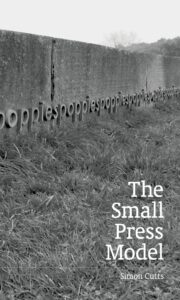In his new Uniformbooks-published ‘The Small Press Model’, poet and artist Simon Cutts attempts to group together artistic approaches to the physicality of the book. Sukhdev Sandhu reviews, finding a text not just about publishing, but about refusing capitalist realism.

Charles Olson, grand mastodon of the Black Mountain poets and self-described “archaeologist of morning”, once declared, “Don’t ever be intimidated by the disdain and disinterest in the world. Get yourself some type, get yourself some paper and print it.” Rousing talk! As gung-ho as “This is a chord, this is another, this is a third. Now form a band.” As seize-the-day as the Desperate Bicycles’ clarion call on ‘The Medium Was Tedium’, “It was easy, it was cheap – go and do it.” DIY: almost always the better path.
Olson’s words are quoted in The Small Press Model, a decades-spanning collection of pieces by Simon Cutts, a poet, artist and publisher, and one of the most quietly important figures in the field of British artist books. His reputation goes back to the mid-1960s when he worked on a little magazine called Tarasque, as well as at the experimental, Nottingham-based Tarasque Press. (The name refers to a mythical animal which lived on the banks of the Rhone and ravaged the surrounding countryside.) There, and later at Coracle Press, he designed and produced scores of booklets, cards, printed matter.
An example of a Simon Cutts publication is The Rubber-Stamp Mini-Printer Series (1993). It’s a slipcased volume of very short poems (each has five lines comprising thirty characters and spaces) printed using a small rubber stamp. The edition runs to a hundred copies. Then there’s A Line Only A Word (2013), described as a “permutational poem” that has been ‘made translucent and only readable in certain conditions of light and air.’ And again, A Fold of Sewn Cotton (1982), which Cutts says was a ‘small thing, almost nothing in a way, just a four-page pamphlet sewn with a single stitch, and on the cover is an image of the single knot inside’.
To some, publications like these will seem like whimsical bagatelles. But whimsy, which involves keeping your eyes off the prize, ignoring other peoples’ ideas of what is or isn’t “important”, is its own kind of independence. Cutts talks fondly of painter Ian Gardner who liked to ‘draw round a piece of toast from his breakfast on a card and send it to a range of friends as a postcard’. Here, as on other occasions, he celebrates small press publishing not just for its immediacy, but for the way that it invites ‘confusion and contradiction’.
Many if not most of the books mentioned in The Small Press Model are published in vanishingly small editions. Some are too fragile to risk being sent out to independent shops on a sell-or-return basis. For a while Coracle had its own shop in South London; when it applied for a rate reduction on the grounds that it added value to the neighbourhood, an official from the Treasurer’s Department announced, “Well sir, we don’t think we can help you in this case. If you were a scout hut, then we could.”
What is the value of Cutt’s titles if so few of them are widely read or seen? Perhaps it lies in their power as ideas or as imaginative prompts. Even to learn about them is consoling. Somebody out there is doing … this?! The act of making is its own reward. Cutts is good at evoking the artisanal, home-assembled aspects of publishing — ‘working from the kitchen table, the cupboard under the stairs, stock held in cardboard boxes’. It’s hard not to feel wistful when he recalls how, in the 1970s and 1980s, East London was full of paper-merchants, engravers, makers of cutters and creasers. ‘Now we are left with trying to get tactility of some sort from an implacable electronic screen.’
Like its publisher Uniformbooks, The Small Press Model celebrates the local, the non-metropolitan, those who have a ‘resolve for a critical alternative to mainstream publishing’. It preaches self-reliance, an ethics and economics of scale, a scepticism towards waving a begging bowl at the Arts Council. There’s a kind of English anarchism at play, echoes of the designs for living that Crass worked so hard to make real, when Cutts talks about his work as a ‘model of self-organisation’.
It’s a model that stands for the dignity of production, the importance of collaboration, the need for alternative networks — and alternative publics. This is a book about publishing. More than that, it’s about refusing capitalist realism, about carving out and holding on to your own space, about how passion should never be a fashion.
*
‘The Small Press Model’ is out now and available here, published by Uniformbooks (£14.00).
Sukhdev Sandhu directs the Colloquium for Unpopular Culture at New York University.